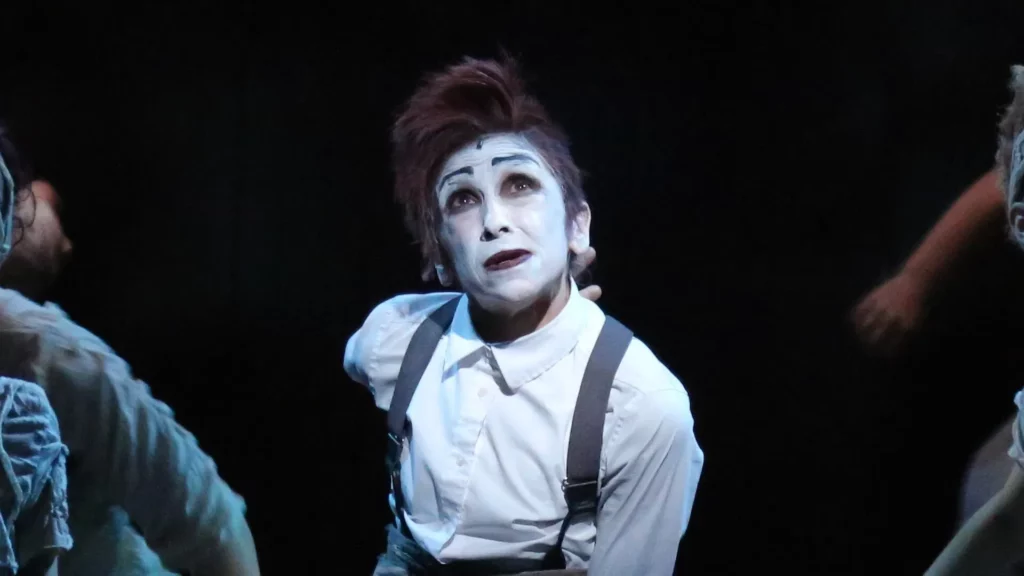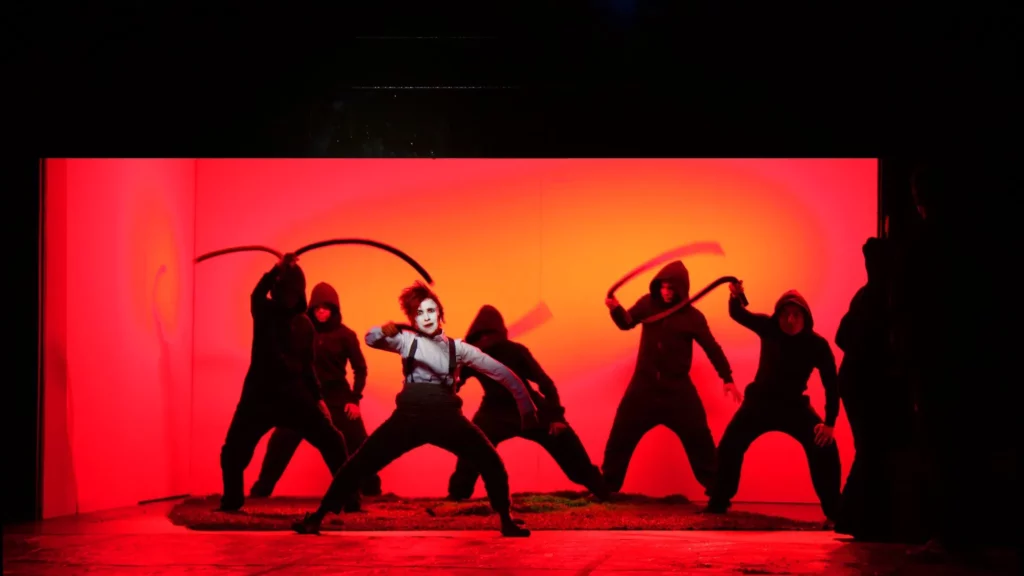A Midsummer Night’s Dream
Taymor’s Visually Arresting but Uneven Faerie Realm

As Ferdosa Abdi, I present my review of Julie Taymor’s 2014 cinematic rendition of Shakespeare’s timeless comedy, “A Midsummer Night’s Dream.”
Julie Taymor, a director known for her bold and imaginative theatrical and cinematic productions, takes on William Shakespeare’s beloved comedy, “A Midsummer Night’s Dream,” in this 2014 adaptation. Originating from her acclaimed stage production for the Theatre for a New Audience in Brooklyn, Taymor brings her signature visual flair to the screen, creating a world of enchantment and theatricality. However, while the film is undeniably visually stunning and boasts moments of brilliance, it occasionally struggles to maintain a consistent tone and pacing, resulting in an experience that is both captivating and somewhat disjointed.
From Stage to Screen: The Journey of Taymor’s Dream
Julie Taymor’s interpretation of “A Midsummer Night’s Dream” first graced the stage in 2013 as the inaugural production at Theatre for a New Audience’s new venue. The critical and audience response to this stage version was overwhelmingly positive, particularly for its innovative visual design and imaginative staging. Recognizing the production’s unique appeal, Taymor decided to capture its essence on film, allowing a wider audience to experience her vision. This transition from stage to screen is evident throughout the film, with its theatrical sensibilities and emphasis on visual storytelling. The film was recorded over multiple performances and edited together, preserving the energy and spontaneity of live theatre while utilizing cinematic techniques to enhance the magical elements of the play.
A Tangled Web of Lovers and Faeries: Plot Analysis
Shakespeare’s intricate plot, with its interwoven stories of Athenian lovers, mischievous faeries, and a group of amateur actors, remains largely intact in Taymor’s adaptation. The film opens with the impending marriage of Duke Theseus to Hippolyta, Queen of the Amazons. Simultaneously, we are introduced to the young lovers: Hermia, who is betrothed against her will to Demetrius, while she loves Lysander. Helena, consumed by her unrequited love for Demetrius, reveals Hermia and Lysander’s plan to flee to the forest.
Entering the realm of the faeries, we encounter Oberon and Titania, the king and queen of the fae, locked in a bitter quarrel over a young Indian boy. In a fit of jealousy, Oberon instructs his mischievous servant Puck to use a love potion on Titania. Oberon also intends for Puck to use the potion on Demetrius to make him fall in love with Helena. However, Puck’s chaotic nature leads to a series of comical mishaps, with both Lysander and Demetrius falling for Helena, creating further confusion and heartbreak among the young Athenians.
Meanwhile, a group of “rude mechanicals,” led by the enthusiastic but inept Nick Bottom, venture into the forest to rehearse a play for the Duke’s wedding. Puck, ever the trickster, transforms Bottom’s head into that of an ass, and the bewitched Titania falls madly in love with him, leading to some of the play’s most humorous and surreal moments.
Taymor’s film embraces the play’s themes of love, illusion, and the transformative power of the imagination. The forest becomes a dreamlike space where reality blurs, and the characters are subject to the whims of the faeries and their potent magic. The film culminates in a resolution where the love potion’s effects are reversed (mostly), the human and faerie worlds are reconciled, and the Duke and Hippolyta, along with the two pairs of lovers, prepare for their weddings, while Bottom and his fellow mechanicals perform their hilariously flawed play.

Characters Illuminated: Performances in the Faerie Light
Taymor’s casting choices bring a diverse and talented ensemble to Shakespeare’s iconic characters. Kathryn Hunter delivers a standout performance as Puck, embodying the mischievous spirit with a physicality that is both captivating and unsettling. Her portrayal is often cited as one of the film’s highlights, capturing the character’s playful malevolence and acrobatic agility.
David Harewood brings a regal authority to the role of Oberon, while Tina Benko portrays Titania with a captivating blend of power and vulnerability. The four Athenian lovers – Lysander (Daniel Reece), Hermia (Lilly Englert), Demetrius (Zach Appelman), and Helena (Mandy Patinkin, in a gender-blind casting choice that adds an intriguing layer to the character) – navigate the comedic chaos of their romantic entanglements with varying degrees of success. While some critics found their performances less impactful than the faerie characters, they effectively convey the youthful passion and confusion at the heart of the play.
Max Casella’s portrayal of Nick Bottom is suitably comical, embracing the character’s buffoonery with gusto. His scenes with Titania are particularly memorable, highlighting the absurdity of their enchanted romance. The supporting cast, including the other mechanicals, contribute to the film’s overall sense of theatrical whimsy.
A World Woven in Light and Shadow: Cinematography
The visual language of Taymor’s “A Midsummer Night’s Dream” is one of its most striking features. Cinematographer Rodrigo Prieto captures the dreamlike atmosphere of the forest with a painterly eye, utilizing a rich color palette and imaginative lighting to create a sense of enchantment. The film seamlessly blends elements of stagecraft with cinematic techniques, often incorporating theatrical props and staging within the natural forest setting.
The camera work is dynamic, moving fluidly through the faerie realm and capturing the actors’ performances with a keen sense of theatricality. Taymor’s signature visual style, evident in her previous works like “Titus” and “Frida,” is on full display here, with creative use of costumes, masks, and fantastical imagery. The film’s visual inventiveness is often praised, creating a truly immersive and magical experience for the viewer.
Critical Perspectives and Audience Reception
Critical reception for Taymor’s “A Midsummer Night’s Dream” was somewhat divided. While many praised its visual splendor and Kathryn Hunter’s performance as Puck, some critics found the film’s pacing uneven and its overall impact less cohesive than her stage production. On Rotten Tomatoes, the film has an audience score of 63%, indicating a generally positive reception from viewers who appreciated its imaginative approach to the classic play.
User reviews on IMDb are also generally favorable, with many highlighting the film’s stunning visuals and creative interpretation of Shakespeare’s work. Some viewers noted that the film might not appeal to those seeking a more traditional adaptation, but praised Taymor’s bold and artistic vision.
Box Office and Popularity: A Niche Enchantment
As a filmed version of a stage production, “A Midsummer Night’s Dream” likely had a limited theatrical release and its box office performance would not typically be compared to mainstream studio films. Information regarding its specific box office earnings is not readily available. However, its availability on streaming platforms and its continued interest among Shakespeare enthusiasts suggest a sustained level of popularity within a niche audience. The film’s primary appeal lies in its artistic merit and Julie Taymor’s unique directorial vision, rather than broad commercial success.
Final Verdict: A Visually Captivating but Flawed Dream
Julie Taymor’s “A Midsummer Night’s Dream” is an undeniably ambitious and visually arresting adaptation of Shakespeare’s beloved comedy. Her background in theatre shines through, creating a film that is both cinematic and theatrical in its approach. While the film’s pacing and overall cohesion might not be perfect, its moments of visual brilliance, Kathryn Hunter’s captivating performance as Puck, and its imaginative interpretation of the faerie realm make it a worthwhile experience for those who appreciate bold and unconventional filmmaking. It serves as a testament to Taymor’s unique artistic vision and offers a fresh perspective on a timeless classic.
| Category | Information |
|---|---|
| Director | Julie Taymor |
| Based on | The play “A Midsummer Night’s Dream” by William Shakespeare |
| Main Cast | Kathryn Hunter, David Harewood, Tina Benko, Max Casella, Daniel Reece, Lilly Englert, Zach Appelman, Mandy Patinkin |
| Runtime | 2 hours 25 minutes |
| Genre | Comedy, Fantasy |
| IMDb Rating | 6.4/10 |
| Rotten Tomatoes Audience Score | 63% |
| TMDB Rating | 6.3/10 |
| Critical Reception | Mixed; praised for visuals and Kathryn Hunter’s performance, criticized for pacing and unevenness. |
| Box Office | Limited information available, likely a limited theatrical release typical for a filmed stage production. |
| Origin | USA |
| Release Year | 2014 |
